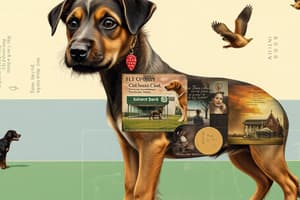Podcast
Questions and Answers
Which of the following is NOT a sign that a dog may have separation anxiety?
Which of the following is NOT a sign that a dog may have separation anxiety?
- Moving to a new home with the owner
- Sudden change in owner’s interaction time
- Dogs kenneled frequently for long hours
- Excessive barking with no observable reason (correct)
What is a common behavioral sign of separation distress in dogs?
What is a common behavioral sign of separation distress in dogs?
- Calm demeanor when left alone
- Increased frequency of urination/defecation (correct)
- Ignoring owner’s arrival
- Sitting quietly by the door
What is a potential cause of separation anxiety in dogs?
What is a potential cause of separation anxiety in dogs?
- Lack of exercise in adulthood
- Daily routine with varied time spent with owner
- Understanding commands effectively
- Long periods of alone time during puppyhood (correct)
Which of the following characteristics can contribute to a dog’s susceptibility to separation anxiety?
Which of the following characteristics can contribute to a dog’s susceptibility to separation anxiety?
What can escalate a dog's anxiety after separation begins?
What can escalate a dog's anxiety after separation begins?
Which medication is commonly used to treat canine separation anxiety?
Which medication is commonly used to treat canine separation anxiety?
What is a key treatment consideration for dogs with separation anxiety?
What is a key treatment consideration for dogs with separation anxiety?
Which of the following behaviors indicates a dog may exhibit separation anxiety upon a human’s departure?
Which of the following behaviors indicates a dog may exhibit separation anxiety upon a human’s departure?
What effect do increased serotonin levels have on dogs?
What effect do increased serotonin levels have on dogs?
Which carbohydrate source is suggested to improve serotonin levels in dogs?
Which carbohydrate source is suggested to improve serotonin levels in dogs?
What is the impact of crating on dogs with moderate cases of canine separation anxiety?
What is the impact of crating on dogs with moderate cases of canine separation anxiety?
Which sign is NOT typically associated with a dog experiencing fear?
Which sign is NOT typically associated with a dog experiencing fear?
What is a potential consequence of not understanding a dog's body language?
What is a potential consequence of not understanding a dog's body language?
How can mental stimulation be increased for dogs?
How can mental stimulation be increased for dogs?
Why is it important to keep a dog within its threshold during training?
Why is it important to keep a dog within its threshold during training?
What is 'Second Dog Syndrome'?
What is 'Second Dog Syndrome'?
What is a recommended approach when greeting a dog for the first time?
What is a recommended approach when greeting a dog for the first time?
Which item can provide comfort to a dog when their owner is absent?
Which item can provide comfort to a dog when their owner is absent?
What should you do if you feel like you are going slow in your interactions with a dog?
What should you do if you feel like you are going slow in your interactions with a dog?
What type of music is recommended to soothe dogs during the day?
What type of music is recommended to soothe dogs during the day?
What behavior should owners exhibit when arriving home to reduce stress for their dog?
What behavior should owners exhibit when arriving home to reduce stress for their dog?
What should you do if a dog shows signs of anxiety during a training session?
What should you do if a dog shows signs of anxiety during a training session?
Which factor is not considered a risk factor for developing canine separation anxiety?
Which factor is not considered a risk factor for developing canine separation anxiety?
What is a common misconception about the removal of puppies from their mother?
What is a common misconception about the removal of puppies from their mother?
What is the primary purpose of separation anxiety in canid species?
What is the primary purpose of separation anxiety in canid species?
What should be done if a dog's fear trigger appears unexpectedly and the dog becomes aggressive?
What should be done if a dog's fear trigger appears unexpectedly and the dog becomes aggressive?
Why is desensitization and counter-conditioning described as a slow process?
Why is desensitization and counter-conditioning described as a slow process?
Which statement about a dog's response to isolation is true?
Which statement about a dog's response to isolation is true?
What outcome should be considered if a dog's quality of life is compromised?
What outcome should be considered if a dog's quality of life is compromised?
What is one effect of excessive vocalization in a puppy due to separation anxiety?
What is one effect of excessive vocalization in a puppy due to separation anxiety?
What is an essential aspect of canine education when addressing behavioral issues?
What is an essential aspect of canine education when addressing behavioral issues?
What should handlers prioritize to ensure the safety of a fearful dog?
What should handlers prioritize to ensure the safety of a fearful dog?
Which technique is NOT recommended for managing a fearful dog?
Which technique is NOT recommended for managing a fearful dog?
What is the primary focus of impulse control in handling fearful dogs?
What is the primary focus of impulse control in handling fearful dogs?
Which step should be taken last when addressing a fearful dog's behavior?
Which step should be taken last when addressing a fearful dog's behavior?
Which of the following is a misconception about managing fearful dogs?
Which of the following is a misconception about managing fearful dogs?
What best describes the nature of fear?
What best describes the nature of fear?
Which response is NOT one of the Four 'F' responses of Fear?
Which response is NOT one of the Four 'F' responses of Fear?
How does fear differ from anxiety?
How does fear differ from anxiety?
What is the first step in teaching a dog to accept handling?
What is the first step in teaching a dog to accept handling?
Which function does the nervous system NOT perform?
Which function does the nervous system NOT perform?
Why is it important to work with the dog in short sessions?
Why is it important to work with the dog in short sessions?
What should you do when the dog shows discomfort during handling?
What should you do when the dog shows discomfort during handling?
What is a common physiological change when experiencing fear?
What is a common physiological change when experiencing fear?
How should you introduce new handling techniques to the dog?
How should you introduce new handling techniques to the dog?
What is a key benefit of having family and friends participate in the program?
What is a key benefit of having family and friends participate in the program?
When should you change the length of your touch during handling?
When should you change the length of your touch during handling?
What role does the cue 'Yes' play in the training process?
What role does the cue 'Yes' play in the training process?
What should be maintained to ensure the dog's positive feelings towards handling?
What should be maintained to ensure the dog's positive feelings towards handling?
What is primarily governed by the limbic system in dogs?
What is primarily governed by the limbic system in dogs?
What characterizes the stress threshold in dogs?
What characterizes the stress threshold in dogs?
What functions are primarily associated with the cerebral cortex in dogs?
What functions are primarily associated with the cerebral cortex in dogs?
If a dog frequently relies on its sympathetic nervous system, what is likely to occur?
If a dog frequently relies on its sympathetic nervous system, what is likely to occur?
How can the fight or flight response be defined?
How can the fight or flight response be defined?
What is the primary goal of counter conditioning in behavioral training?
What is the primary goal of counter conditioning in behavioral training?
What is the effect of proper habituation to a muzzle before its use?
What is the effect of proper habituation to a muzzle before its use?
What does systematic desensitization begin with?
What does systematic desensitization begin with?
Which option best describes counter commanding?
Which option best describes counter commanding?
Why might a proper modification plan not prevent regression in behavior?
Why might a proper modification plan not prevent regression in behavior?
What is the primary goal of establishing a consistent routine for a dog?
What is the primary goal of establishing a consistent routine for a dog?
Which of the following best describes systematic desensitization?
Which of the following best describes systematic desensitization?
What should owners do if a dog shows anxiety responses to pre-departure cues?
What should owners do if a dog shows anxiety responses to pre-departure cues?
How should an owner gradually expose the dog to departure cues?
How should an owner gradually expose the dog to departure cues?
What is counter conditioning used for in relation to dogs and departure cues?
What is counter conditioning used for in relation to dogs and departure cues?
What might indicate that an owner should consult a veterinarian regarding their dog's anxiety?
What might indicate that an owner should consult a veterinarian regarding their dog's anxiety?
What are pre-departure routines?
What are pre-departure routines?
Which activity should NOT be included in daily routines for a dog?
Which activity should NOT be included in daily routines for a dog?
Flashcards are hidden until you start studying
Study Notes
Positive Approach Canine Education
Progress
- Emphasizes a slow, steady, and successful training approach.
- Avoid pushing the dog past their comfort level; prioritize their relaxation and success.
- Nervous behavior in dogs warrants an immediate end to the session.
- Progress depends on practice frequency, temperament, and age of the dog.
- Rehoming or euthanasia may be necessary if the dog poses a danger to others or suffers a reduced quality of life.
Separation Distress and Anxiety
- Natural behavior in social canids, particularly in domestic dogs.
- Separation distress helps puppies remain close to their mother and family unit.
- Early weaning results in increased anxiety due to abrupt removal from mother and littermates.
- Excessive vocalizations by the puppy can escalate into neurotic behaviors if not addressed.
Risk Factors for Separation Distress
- Lack of gradual exposure to absences increases vulnerability.
- Harsh disciplinary practices can exacerbate anxiety.
- Dogs adopted from shelters may carry unresolved separation issues.
Signs of Separation Anxiety
- Vocalizations (barking, whining) indicate distress.
- Physical actions include scratching, digging, pacing, and inappropriate chewing.
- Increased urination/defecation, drooling, and exaggerated greetings may be present.
Expression of Distress
- Dogs respond to environment cues pre-departure that trigger anxiety.
- Distress escalates typically within 30 minutes after the owner's departure but may vary.
Treatment Recommendations
- Focus on individualized treatment plans for each dog.
- Medications like Clomicalm can help manage symptoms by increasing serotonin levels.
Increased Serotonin Levels
- Higher serotonin levels are associated with reduced fear and stress in dogs.
Nutritional Intervention
- High-quality dog food is crucial; inferior diets may lower serotonin levels.
- Foods with rice, potato, or barley are preferable over corn-based diets.
Mental and Physical Stimulation
- Engaging in training, exercise, and activities helps manage energy levels and stress.
Crate Use
- Crating can worsen anxiety for many dogs; individual assessment is necessary.
Second Dog Syndrome
- Adding a second dog may not resolve separation anxiety and can escalate stress for the first dog.
Additional Supportive Techniques
- Use scent items, soothing noises, and a consistent routine to promote comfort.
- Awareness of pre-departure cues can help prevent anxiety; modify routines to desensitize triggers.
Importance of Body Language
- Effective communication requires understanding dog body language to ensure safety and comfort.
- Signs of fear include low posture, averted gaze, and tense muscles; handlers must remain calm.
Behaviour Signs of Fear and Anxiety
- Behaviors indicate distress; dogs may hide, pant excessively, lick lips, or become hyper-vigilant.
Key Approaches
- Implement desensitization and classical conditioning (DS and CC) for handling fears.
- Progressively teach dogs to embrace handling through positive reinforcement methods.
Session Nine Exam Highlights
- Fear is a visceral response to perceived threats; anxiety indicates an uncontrollable state.
- The limbic system governs emotions while the cerebral cortex manages advanced cognitive functions.
- Maintaining a safe learning environment is critical to prevent fear escalation.
Handling Sensitivities Program
- Employ gradual exposure to handling; ensure the dog is comfortable before advancing steps.
- Regular reinforcement is crucial in maintaining positive associations with handling.
General Notes
- Slow progression is essential; end training sessions positively before stress levels rise.
- Consistent routines, along with careful evaluation of progress, lead to effective behavior modification.
Studying That Suits You
Use AI to generate personalized quizzes and flashcards to suit your learning preferences.




